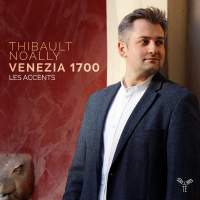Texte paru dans: / Appeared in: |
|
|
Outil de traduction ~ (Très approximatif) |
|
|
Reviewer: Michael
De Sapio
This collection of duo and
trio sonatas of the Venetian High Baroque includes two that have never been
recorded before: those by Giuseppe Torelli and the fairly obscure Evaristo
Felice Dall’Abaco (1675–1742). The Torelli piece is preserved in Dresden in
a copy formerly owned by the great German violinist Pisendel (who may have
been the dedicatee of Bach’s Sonatas and Partitas). The Pisendel connection
sheds light on the Torelli, which seems to straddle the worlds of Biber and
Corelli. We open with an arpeggiated fantasia, and there are fugal movements
with the violin imitating itself contrapuntally in multiple-stops. Torelli
also exploits such other devices as brusque repeated staccato notes and
rapidly cascading slurred arpeggios.
Dall’Abaco’s piece has some
definite Corellian touches but is more dramatic and extrovert than Corelli.
In place of a slow third movement, there is a Passacaglio in vivace tempo,
and the sonata is rounded out by a Giga. Overall, though, the Dall’Abaco is
not as brilliant or original as the composers he took as his models.
Antonio Caldara’s two trio
pieces—a sonata and a Ciaccona—are also very Corellian in style, although
Caldara adds a few surprising Purcell-like chromatic passages. The sonata is
rather sober and learned in style, one might almost say Roman.
Francesco Antonio Bonporti’s
Invenzioni for violin and continuo attracted the eye of no less than J. S.
Bach, who transcribed four of them for harpsichord. These are essentially
sonatas, although Bonporti has masked the genre by designating the four
movements as Lamentevole, Balletto, Aria, and Fantasia. The “invention”
label may refer to Bonporti’s basing each of his movements on a particular,
persistent motif. The violin writing is dense with figuration, leaping
passage work, and double-stops. Vivaldi’s B Sonata belongs to the “Manchester” collection. It opens with a magical, poetic Preludio—Largo which, to me, suggests dawn on a Venetian lagoon. The third-movement Sarabanda is unusually searching and profound, and the remaining two fast movements offer plenty of athletic display for the soloist.
Albinoni’s opus 4 Violin
Sonatas are superb, and it’s a mystery that they haven’t attracted more
attention from performers. Perhaps Vivaldi’s ubiquity has caused us to
undervalue Albinoni. In any case, the Sonata No. 5 in G Minor is notable for
two dreamy slow movements with arresting chromatic twists. The last movement
Presto is carried along on the current of almost continuous swirling
16th-note passage work. Albinoni’s structural framework is akin to Corelli’s;
but once again there seems to be an older Germanic tradition in the
background. I know the Albinoni sonatas from reading and playing them, and
it was a pleasure to hear a rendition of one of them for the first time. Vivaldi’s Follia variations are extra-familiar, and they round out an intriguing and well-played disc. Thibault Noally’s Baroque violin playing is technically assured, lyrical, expressive, and tasteful.
I feel that the continuo
cellist occasionally takes too assertive a role in proceedings, which seems
to be a growing trend nowadays. I am also not a fan of furious theorbo
thrumming, though thankfully there’s only a little of that here. Longer silences could have been provided between the individual works on the disc; the C Minor of the Bonporti is especially jarring, following so close on the heels of the E Minor of the Torelli. Recorded sound is resonant and sympathetic to the performers. Olivier Fourés’s booklet notes have some solid information about the pieces along with a serving of poetic fluff (maybe it sounded better in French). This disc demonstrates how Venetian composers of the High Baroque consolidated the accomplishments of the Italian and German violin schools of the previous century; indeed, several of these composers lived and worked in the German lands. Beyond this, the disc is simply a well-chosen and well-played selection of Baroque pieces. | |
|
Support us financially by purchasing this disc from eiher one of these
suppliers. |
|
|
|
|
|
Cliquez l'un ou l'autre
bouton pour découvrir bien d'autres critiques de CD |
|




